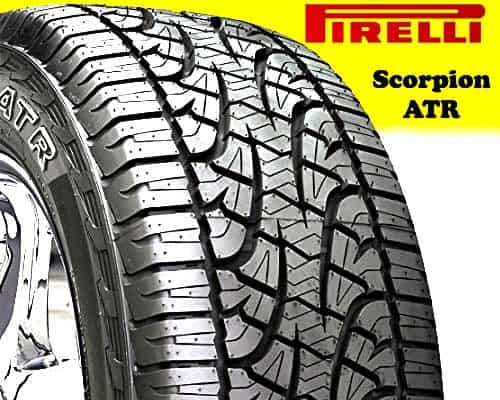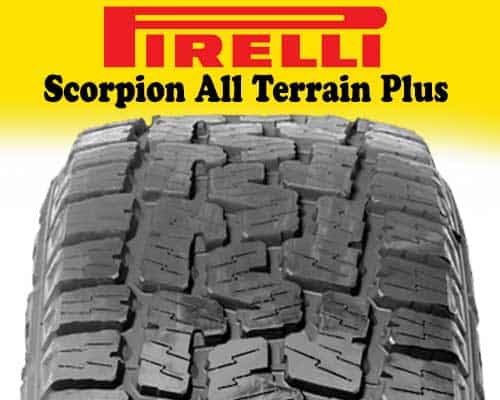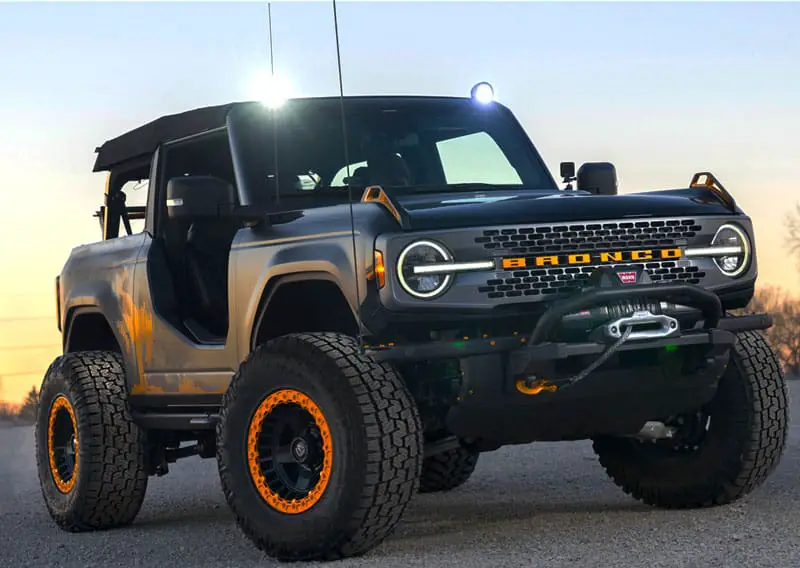Both are All-Terrain (A/T) tires where Pirelli Scorpion All Terrain plus has better off-road traction while ATR focuses more on on-road performance.
The aggressive design of the All-Terrain Plus tread blocks along with deep grooves creates a more balance between on and off-roading experience while the symmetrical tread block design of ATR is more focused on the on-road driving experience.

The build quality of the All-Terrain Plus tire makes it stand out due to its high durability. Keep reading till the end to find an in-depth analysis of the key differences between both tires.
Table of Contents
Comparing the All Terrain Plus and the Pirelli Scorpion ATR
Pirelli Scorpion ATR

Pirelli Scorpion AT Plus


Vs

Pirelli Scorpion All-Terrain Plus tire has an aggressive symmetrical tread block design with wide grooves which creates minimal contact area with the road, decreasing its on-road traction. The wider sipes allow the tires to avoid hydroplaning while traveling on road. The high void ratio helps the tires perform better in mud and icy terrain.

The deep grooves don’t allow the tire to get stuck inside mud by throwing the mud backward and moving the tire forward. It also has an aggressive shoulder design which increases handling in muddy terrain by allowing the mud to pass through them. It also has conical stone ejectors which don’t allow stones to get inside the tire hence boosting its traction in rocky terrain. The build of the tire is strong which allows it to withstand extreme off-roading conditions.

Pirelli Scorpion ATR also has a symmetrical tread design but with a lower void ratio compared to its competitor. The narrow grooves of the tire increase its contact area with the road hence improving the on-road traction. Shallow sipes are also embedded to avoid hydroplaning but compared to wider grooves and deeper sipes of All Terrain Plus, the wet traction of ATR is not comparable. Since it has narrow grooves that don’t allow traction in mud and snow, making the grip of the tire very minimal. The absence of stone ejectors makes the rock traction of this tire very limited. Its build is also not as strong as that of All Terrain Plus. Due to these characteristics, ATR is preferred mostly for on-road driving.
On-Road Traction Comparison

All Terrain Plus has wider grooves decreasing its tread block area in contact with the road hence decreasing its on-road traction. Therefore, its traction on-road is not that great. But when it comes to wet conditions, the wider grooves and deep sipes of the tire allow it to easily navigate through the watery surfaces. The wider grooves allow the water to easily move through the tire avoiding hydroplaning. This tire can be confidently used in the rainy season due to its remarkable wet traction.

The symmetrical design of ATR allows a decent patch of tread block to meet the road since its grooves are narrow which allows good traction. Therefore, its on-road traction is extremely well. But when it comes to wet traction, ATR has narrow grooves and shallow sipes which can hold their own in wet conditions but compared to the wider grooves and deep sipes of All Terrain Plus, the ATR lacks far behind in wet traction.
Off-Road Traction Comparison

Mud Terrain
In mud terrain, the grooves play an important role in the traction of the tire. The grooves allow the tire to move forward by throwing the mud in the backward direction. The wider grooves of the All-Terrain Plus do the same for it by throwing mud backward efficiently. The notched design of its shoulders also allows the easy passage of mud through it allowing good handling. Since it’s an AT tire, the extreme mud condition may prove to be difficult to navigate. Still, compared to ATR its mud traction is much better. high void ratio
ATR is a tire with narrow grooves that might get stuck inside the mud as there is not enough gap between the tread blocks to efficiently throw the mud backward. This tire should not be used on muddy terrain as the grooves will fill with mud and the tire will completely lose grip with the ground.
Snow Terrain
Just like mud, snow is also navigated with the help of grooves. Wider grooves just like in the case of All-Terrain Plus allow easy driving by throwing the snow backward with the help of grooves and maintaining its traction in the snowy terrain. But the tire is not efficient in deep snow since its grooves are not wide enough to throw the deep snow backwards and it may lose traction.
ATR performs worse in snow conditions as the narrow grooves don’t allow the efficient operation of the tire because they get stuffed with snow due to their poor ability to throw it backwards. The All-Terrain Plus tire is the favored choice in snowy conditions.
Rock Terrain
All Terrain Plus has wider grooves which allow good grip from any angle of approach in rocky terrain. The conical stone ejectors avoid the stones getting stuck inside the tire making it suitable for rocky terrain. These characteristics allow this tire to easily move through rocks or pebbles.
ATR’s narrower grooves don’t allow it to be used in rocky terrain as the grooves of the tire don’t offer decent grip on rocks. The absence of stone ejector design also adds negatively to the performance of the tire in rocky area. The All-Terrain Plus is better equipped to handle such conditions.
Comfort Comparison
The wide grooves of the All-Terrain Plus tire make more sound (compared to ATR) when traveling on-road at high speed as the air gets trapped inside the grooves of the tire and produces noise. The noise is produced by the particles of air trapped inside the grooves as they hit the walls of the tire back and forth.
ATR on the other side is more prone to noise because there are narrow grooves inside this tire which don’t allow much air to get trapped inside and produce noise. These tires provide a very comfortable journey compared to their counterpart, on-road.
Durability and Treadwear
The high void ratio of the All-Terrain Plus tire allows smaller patch of tread to be in contact with the ground decreasing its rolling resistance since less force is required to roll the tire. The lower rolling resistance leads to lower treadwear, increasing its durability. It consists of polyester casing along with two steel belts and nylon reinforcements to make it highly durable.
The lower void ratio means a higher contact patch, leading to the higher rolling resistance of ATR. Higher rolling resistance results in higher treadwear of the tire which in turn decreases the durability. It consists of a Silica enhanced tread compound along with two steel belts and a nylon cord which helps in high-speed handling, but it cannot counter the strong built of All Terrain Plus. Hence ATR has lesser durability compared to the All-Terrain Plus.
Value to Money:
The All-Terrain Plus tire is costlier than ATR due to its enhanced performance in off-roading along with the strong built and higher durability of the tire. All Terrain Plus tire also allow greater mileage compared to ATR. The ATR performs much better on-road and is focused less on off-roading.
If you are off-road enthusiastic All Terrain Plus tire is preferable while ATR is preferred for a better on-road driving experience.
Lets Summarize things:
Both all terrain tires are slightly different from each other, where the Pirelli Scorpion ATR is better on overall dry road traction. And the Pirelli All Terrain Plus with 3 peak mountain snowflake rating is great on snow.
If we talk tread it’s also seen slightly better on AT Plus.


